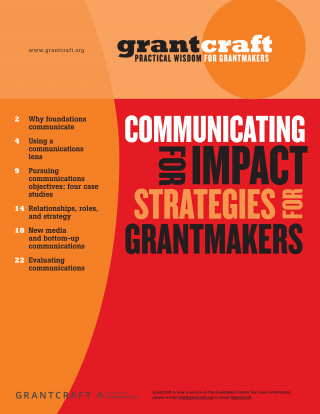Communicating For Impact Strategies for Grantmakers
Foundation communications goes far beyond an annual report or the occasional press release about grantees. And it's no longer the exclusive domain of big foundations, communications staff, or consultants. Integrating communications is critical to advancing programmatic goals. See how grantmakers use a "communications lens" to develop strategy, evaluate impact, take advantage of new media technologies, and more.
Highlights
- Integrating a communications lens into grantmaking strategy
- New media and bottom-up communications
- Using the foundation's voice
What's in the Guide?
- Why Foundations Communicate: "Communications" used to be seen as synonymous with "publicity." Increasingly, however, funders are thinking of communications as a fully integrated part of grantmaking strategy. Communications can help grantees and programs connect effectively with clients, decisionmakers, donors, peers, the press, and other stakeholders. And that means greater impact.
- Using a Communications Lens: To use a communications lens is to ask: What do we want to achieve? Who needs to be onboard if we're going to achieve it? And how best do we reach them? Those questions can help funders and grantees connect with audiences, broaden the base of participation on an issue, and link program design with outcomes.
- Pursuing Communications Objectives: Four Case Studies: These case studies take a closer look at the grantmaking strategies behind four ambitious communications projects. Their objectives: organize immigrants to identify and address health problems, advocate for same-sex marriage rights, connect with children's theater audiences, and define an organization's basic goals and how it attracts volunteers.
- Relationships, Roles, and Strategy: Effective communications is the sine qua non of building and sustaining relationships. When grantmakers communicate well, internally and externally, with grantees, consultants, and colleagues, they can promote more effective communications among their grantees.
- New Media and Bottom-up Communications: Enlist, mobilize, listen: grantmakers are learning about new media, and the activities have a decidedly participatory flavor. A new paradigm is emerging as social media and other nontraditional communications vehicles come into wider use.
- Evaluating Communications: How can a press conference, a webinar, or an education campaign be reliably linked to changes in public behavior or policy? Despite the challenges, grantmakers say that it's important to measure the scope and quality of communications work, and how it contributes to overall program outcomes.

-
Link to Communicating For Impact
Using a “Communications Lens”
If communications is strategy, why is it so often squeezed in at the very end? A consultant who frequently advises foundations and nonprofits on communications described a typical scenario: “We’ll get a call from an organization saying, ‘We have a report with some really interesting findings on education in California, and we want to release it in three weeks. Will you help us?’
Read more -
Link to Communicating For Impact
Evaluating Communications
Three pieces of practical advice for evaluating communications work:
Read more -
Link to Communicating For Impact
Using New Media in Communication
However you decide to use new media tools, remember that the fundamental questions of sound communications strategy still apply: What are my objectives? Who am I trying to reach? What do I want them to do? What is the best way to reach and engage them? And finally, is social media the most effective way to do so?
Read more -
Link to Communicating For Impact
“Pre-Nups” for Funders and Filmmakers
We asked Active Voice's Ellen Schneider for tips grantmakers ought to keep in mind as they consider funding a documentary film or other media project. Here’s her advice:
Read more -
Link to Communicating For Impact
New Media and Bottom Up Communications
Call it participatory communications, interactive communications, or something else entirely: whatever you call it, there’s something new going on, and it’s definitely multidirectional. It’s about not just communicating to but communicating with or among. And new technologies may be driving the change.
Read more -
Link to Communicating For Impact
On Working with Other Foundation Staff
Funders who are part of existing initiatives face related challenges. “We each have specific agendas,” said a health grantmaker who has partnered with public and private funders on a disease eradication campaign.
Read more -
Link to Communicating For Impact
On Working with Communications Staff
One program officer put it this way: ”‘Spin’ and ‘messaging’ can sometimes make it feel like the nuance is lost. The story gets too simplified.” A common tension around communications for program officers lies in the winnowing of content that communications officers often seek in an effort to make a message simpler and more compelling; program staff may feel that complex problems can only be reduced so much.
Read more -
Link to Communicating For Impact
Relationships, Roles, and Strategy
Wait for Buy-In. Rethinking communications can be both time-consuming and threatening to the status quo for some nonprofits,” said a communications consultant, and funders may have to “sell” the idea to grantees.
Read more -
Link to Communicating For Impact
Pulling Audiences In, Getting Research Out
One unusual tool is Chartcart, a utility that enables users to “create a presentation using commonwealth fund charts”. As the website explains, readers can browse a large collection of charts, arranged by topic (such as “health care quality,” “equity and special populations,” “international health policy”), and select a collection that downloads pretty much instantly to the user’s computer.
Read more -
Link to Communicating For Impact
What Nonprofits Use Communications For
When foundations support communications by nonprofits, what is it for?
Read more
Foundation communications goes far beyond an annual report or the occasional press release about grantees. And it's no longer the exclusive domain of big foundations, communications staff, or consultants. Integrating communications is critical to advancing programmatic goals. See how grantmakers use a "communications lens" to develop strategy, evaluate impact, take advantage of new media technologies, and more.
Highlights
- Integrating a communications lens into grantmaking strategy
- New media and bottom-up communications
- Using the foundation's voice
What's in the Guide?
- Why Foundations Communicate: "Communications" used to be seen as synonymous with "publicity." Increasingly, however, funders are thinking of communications as a fully integrated part of grantmaking strategy. Communications can help grantees and programs connect effectively with clients, decisionmakers, donors, peers, the press, and other stakeholders. And that means greater impact.
- Using a Communications Lens: To use a communications lens is to ask: What do we want to achieve? Who needs to be onboard if we're going to achieve it? And how best do we reach them? Those questions can help funders and grantees connect with audiences, broaden the base of participation on an issue, and link program design with outcomes.
- Pursuing Communications Objectives: Four Case Studies: These case studies take a closer look at the grantmaking strategies behind four ambitious communications projects. Their objectives: organize immigrants to identify and address health problems, advocate for same-sex marriage rights, connect with children's theater audiences, and define an organization's basic goals and how it attracts volunteers.
- Relationships, Roles, and Strategy: Effective communications is the sine qua non of building and sustaining relationships. When grantmakers communicate well, internally and externally, with grantees, consultants, and colleagues, they can promote more effective communications among their grantees.
- New Media and Bottom-up Communications: Enlist, mobilize, listen: grantmakers are learning about new media, and the activities have a decidedly participatory flavor. A new paradigm is emerging as social media and other nontraditional communications vehicles come into wider use.
- Evaluating Communications: How can a press conference, a webinar, or an education campaign be reliably linked to changes in public behavior or policy? Despite the challenges, grantmakers say that it's important to measure the scope and quality of communications work, and how it contributes to overall program outcomes.


